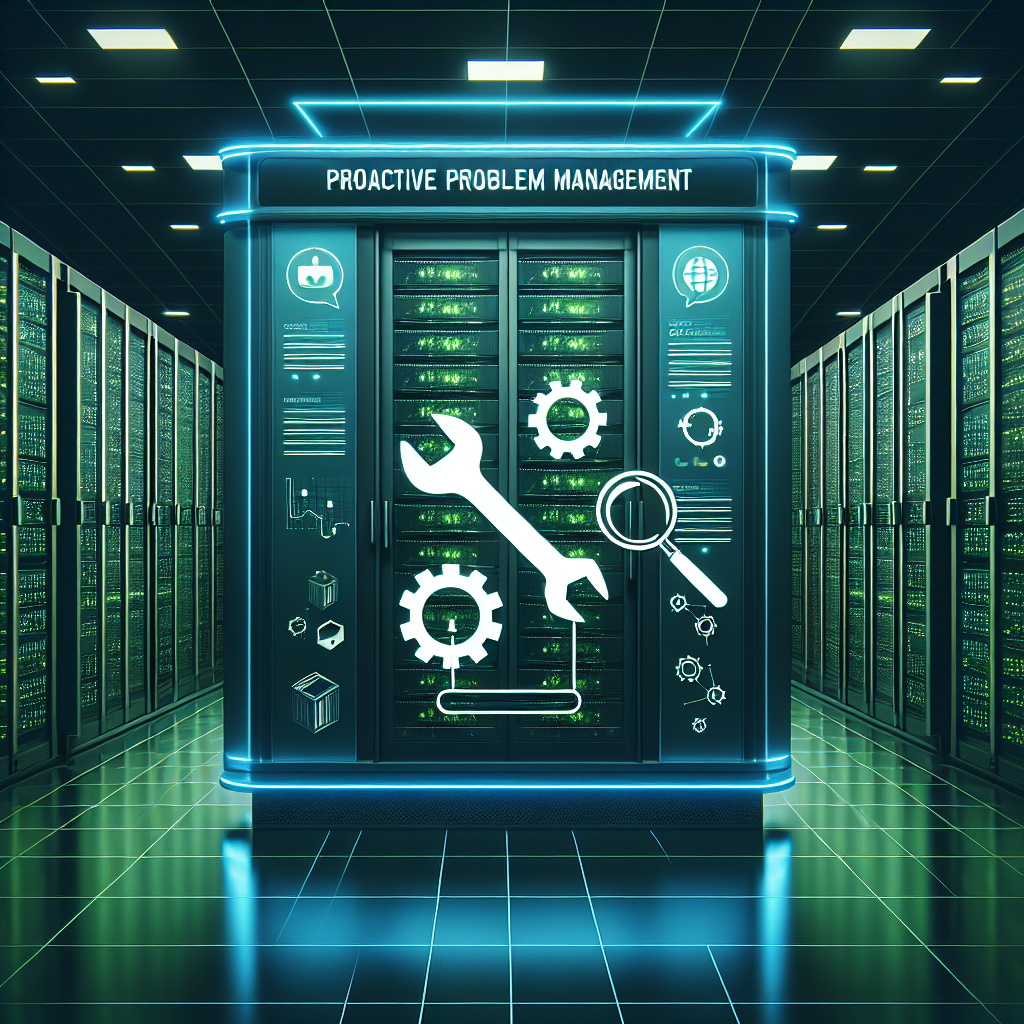Your cart is currently empty!
Tag: Data Center Problem Management

Top Tips for Efficient Data Center Problem Management
Data centers are the backbone of any organization, housing critical infrastructure and storing vast amounts of data. However, with the increasing complexity and scale of data centers, problems are bound to arise. Efficient problem management is crucial to ensure that data center operations run smoothly and downtime is minimized. Here are some top tips for efficient data center problem management:1. Proactive Monitoring: Implementing a robust monitoring system is key to identifying potential issues before they escalate. By monitoring key performance indicators such as temperature, power usage, and network traffic, IT teams can proactively address problems and prevent downtime.
2. Incident Documentation: It is essential to accurately document all incidents and problems that occur in the data center. This information can be invaluable for troubleshooting recurring issues, identifying root causes, and implementing long-term solutions.
3. Root Cause Analysis: When a problem occurs, it is important to conduct a thorough root cause analysis to identify the underlying issue. By addressing the root cause, rather than just the symptoms, IT teams can prevent future incidents from occurring.
4. Change Management: Implementing a robust change management process is essential to prevent problems caused by unauthorized or poorly planned changes. All changes should be carefully documented, tested, and approved before implementation to minimize the risk of disruptions.
5. Collaboration: Effective problem management requires collaboration between different teams within the organization, including IT, facilities, and security teams. By working together and sharing information, teams can quickly resolve issues and prevent them from escalating.
6. Automation: Implementing automation tools can help streamline problem management processes and reduce manual intervention. Automated monitoring, alerting, and resolution can help IT teams respond to issues faster and more efficiently.
7. Continuous Improvement: Continuous improvement is key to efficient problem management. By regularly reviewing incident data, identifying trends, and implementing corrective actions, organizations can continually improve their problem management processes and prevent future incidents.
In conclusion, efficient data center problem management is essential for maintaining the reliability and performance of data center operations. By implementing proactive monitoring, incident documentation, root cause analysis, change management, collaboration, automation, and continuous improvement, organizations can effectively manage and resolve issues in their data centers. By following these top tips, organizations can minimize downtime, improve efficiency, and ensure the smooth operation of their data centers.

Resolving Data Center Challenges: A Comprehensive Approach to Problem Management
In today’s fast-paced and technology-driven world, data centers play a crucial role in ensuring that businesses can operate efficiently and effectively. However, managing a data center comes with its own set of challenges, ranging from hardware failures to software glitches to security breaches. To ensure the smooth operation of a data center, it is essential to have a comprehensive approach to problem management.One of the key challenges that data centers face is downtime. Downtime can be caused by a variety of factors, including hardware failures, software bugs, power outages, and security breaches. To minimize downtime, data center managers need to have a proactive approach to problem management. This includes regularly monitoring the health of the data center’s hardware and software, as well as implementing backup and recovery strategies to ensure that data can be quickly restored in the event of a failure.
Another challenge that data centers face is security breaches. With the increasing threat of cyber attacks, data center managers need to be vigilant in protecting their data from unauthorized access. This includes implementing robust security measures, such as firewalls, encryption, and access controls, as well as regularly monitoring the data center for any signs of suspicious activity.
In addition to downtime and security breaches, data center managers also need to address other challenges, such as scalability, energy efficiency, and compliance. Scalability is important for data centers to be able to accommodate the growing needs of businesses, while energy efficiency is crucial for reducing operating costs and minimizing the environmental impact of the data center. Compliance with industry regulations and standards is also essential to ensure that the data center is operating in a legal and ethical manner.
To effectively address these challenges, data center managers need to take a comprehensive approach to problem management. This includes identifying potential issues before they escalate into major problems, implementing proactive monitoring and maintenance strategies, and developing robust contingency plans to address any issues that may arise. By taking a proactive and comprehensive approach to problem management, data center managers can ensure the smooth operation of their data center and minimize the risk of downtime, security breaches, and other issues that can impact the business.
In conclusion, managing a data center comes with its own set of challenges, but with a comprehensive approach to problem management, these challenges can be effectively addressed. By proactively monitoring and maintaining the data center, implementing robust security measures, and addressing issues such as scalability, energy efficiency, and compliance, data center managers can ensure the smooth operation of their data center and provide the foundation for a successful business.

Troubleshooting Data Center Problems: Best Practices for Success
Data centers are the backbone of modern businesses, housing critical IT infrastructure and data that is essential for day-to-day operations. However, like any complex system, data centers can encounter problems that can disrupt operations and cause downtime. As such, it is crucial for data center administrators to have a solid troubleshooting plan in place to quickly identify and resolve issues when they arise.In this article, we will discuss some best practices for troubleshooting data center problems to ensure success and minimize downtime.
1. Monitor and Analyze Performance Metrics:
One of the first steps in troubleshooting data center problems is to monitor and analyze performance metrics regularly. By tracking key indicators such as CPU usage, memory usage, disk space, and network traffic, administrators can quickly identify any anomalies or bottlenecks that may be causing issues. Utilizing monitoring tools and setting up alerts can help administrators stay ahead of potential problems before they escalate.
2. Document and Maintain an Inventory:
Having a comprehensive inventory of all hardware and software components in the data center is essential for troubleshooting. This inventory should include details such as make, model, serial number, firmware versions, and configurations. By keeping this information up to date, administrators can quickly pinpoint the source of a problem and take appropriate action.
3. Establish Clear Communication Channels:
Effective communication is key in troubleshooting data center problems. Ensure that there is a clear escalation path and communication channels in place so that team members can easily collaborate and share information when addressing issues. Having a centralized ticketing system or incident management platform can help streamline communication and ensure that no issues fall through the cracks.
4. Conduct Regular Maintenance and Testing:
Preventive maintenance is crucial in data center management to avoid potential problems before they occur. Regularly scheduling maintenance tasks such as firmware updates, system patches, and hardware checks can help prevent issues from arising. Additionally, conducting regular testing and simulations can help identify potential vulnerabilities and weaknesses in the data center infrastructure.
5. Implement a Root Cause Analysis Process:
When troubleshooting data center problems, it is important to not only address the immediate issue but also identify the root cause to prevent it from recurring. Implementing a root cause analysis process can help administrators investigate the underlying reasons for problems and implement corrective actions to prevent future incidents.
6. Have a Disaster Recovery Plan in Place:
Despite best efforts, data center problems can still occur, and having a disaster recovery plan in place is essential for ensuring business continuity. This plan should outline procedures for restoring data, applications, and services in the event of a major outage or disaster. Regularly testing and updating the disaster recovery plan is crucial to ensure its effectiveness when needed.
In conclusion, troubleshooting data center problems requires a combination of proactive monitoring, effective communication, regular maintenance, and a systematic approach to problem-solving. By following these best practices, data center administrators can minimize downtime, maximize uptime, and ensure the smooth operation of critical IT infrastructure.

Mitigating Risks in Data Centers through Effective Problem Management
Data centers are essential components of modern businesses, serving as the nerve center for storing, processing, and transmitting critical data. However, with the increasing complexity and volume of data being handled by data centers, the risks associated with downtime and data loss have also escalated. To mitigate these risks, effective problem management strategies must be implemented.One of the key challenges in data center management is identifying and addressing problems in a timely manner. Without a proactive approach to problem management, issues can escalate quickly, leading to costly downtime and potentially damaging impacts on business operations. By implementing effective problem management processes, data center operators can identify and address issues before they develop into major incidents.
There are several key steps that can be taken to mitigate risks in data centers through effective problem management. Firstly, data center operators must establish a robust incident management process that allows for the timely identification and resolution of issues. This process should include clear escalation procedures, defined roles and responsibilities, and regular monitoring of key performance indicators to ensure that issues are being addressed promptly.
In addition to incident management, data center operators should also implement a proactive approach to problem management. This involves identifying potential issues before they occur and implementing preventive measures to minimize the likelihood of downtime or data loss. Regular performance monitoring, capacity planning, and risk assessments can all help to identify potential problem areas and prevent issues from escalating.
Furthermore, data center operators should also prioritize the documentation of incidents and problems, as well as the lessons learned from each situation. By maintaining a comprehensive record of past incidents and their resolutions, data center operators can identify recurring issues and implement long-term solutions to prevent them from occurring again in the future.
Finally, data center operators should also consider the use of automation and artificial intelligence tools to improve problem management processes. These tools can help to identify and resolve issues more quickly, reduce the risk of human error, and improve overall efficiency in managing data center operations.
In conclusion, mitigating risks in data centers through effective problem management is crucial for maintaining the reliability and availability of critical business systems. By implementing proactive problem management processes, documenting incidents and lessons learned, and utilizing automation tools, data center operators can minimize the impact of downtime and data loss, ultimately improving the overall performance and resilience of their data center operations.

Data Center Problem Management: A Comprehensive Approach
Data centers are the backbone of modern businesses, supporting the storage, processing, and distribution of critical data. However, like any complex system, data centers are not immune to problems and issues that can disrupt operations and impact business continuity. To address these challenges, data center problem management is essential to ensure the smooth and efficient functioning of these facilities.Problem management in data centers involves identifying, analyzing, and resolving issues that may arise within the infrastructure. This includes hardware failures, software glitches, network connectivity issues, power outages, and security breaches, among others. A comprehensive approach to problem management is crucial to minimize downtime, optimize performance, and enhance the overall reliability of the data center.
One of the key aspects of problem management is proactive monitoring and alerting. By implementing monitoring tools and systems, data center administrators can track the performance of servers, storage devices, networking equipment, and other critical components in real-time. This allows them to detect potential issues before they escalate into major problems, enabling swift intervention and resolution.
Another important component of problem management is root cause analysis. When an issue occurs, it is essential to determine the underlying cause to prevent its recurrence. This involves investigating the sequence of events that led to the problem, identifying any contributing factors, and implementing corrective actions to address the root cause effectively.
In addition to monitoring and root cause analysis, data center problem management also involves incident management and resolution. When an issue is identified, it is important to respond promptly, communicate with stakeholders, and coordinate efforts to resolve the problem efficiently. This may involve implementing temporary workarounds, escalating the issue to higher-level support teams, or implementing permanent fixes to prevent similar incidents in the future.
Furthermore, problem management in data centers should be integrated with change management processes to ensure that any changes to the infrastructure are carefully planned, tested, and implemented to minimize the risk of disruptions. By aligning problem management with change management, data center administrators can maintain a stable and reliable environment that supports business operations effectively.
Overall, a comprehensive approach to data center problem management is essential to ensure the resilience and availability of critical IT services. By proactively monitoring, analyzing, and resolving issues, data center administrators can minimize downtime, optimize performance, and enhance the overall reliability of the infrastructure. With a focus on proactive problem management, businesses can ensure that their data centers remain operational and efficient, supporting their digital transformation and growth initiatives.

Resolving Data Center Problems: Tips and Tricks for IT Professionals
Data centers are the heart of any organization’s IT infrastructure, housing the servers, storage, and networking equipment that keep businesses running smoothly. However, like any complex system, data centers can experience problems that can disrupt operations and cause headaches for IT professionals. In this article, we will discuss some tips and tricks for resolving data center problems quickly and effectively.1. Monitoring and Maintenance
One of the most important steps in preventing data center problems is to regularly monitor and maintain the equipment. IT professionals should use monitoring tools to keep track of server performance, network traffic, and storage capacity. By staying proactive and addressing issues before they escalate, IT professionals can prevent downtime and ensure the smooth operation of the data center.
2. Identifying the Root Cause
When a problem does arise in the data center, it is crucial to identify the root cause quickly. This may involve troubleshooting hardware failures, network issues, or software glitches. IT professionals should use diagnostic tools and techniques to pinpoint the source of the problem and develop a plan for resolution.
3. Implementing Redundancy
To minimize the impact of hardware failures or network outages, IT professionals should implement redundancy in the data center. This may involve using redundant power supplies, network connections, or storage arrays to ensure that critical systems remain operational even in the event of a failure. By having backup systems in place, IT professionals can reduce downtime and keep the data center running smoothly.
4. Disaster Recovery Planning
In addition to redundancy, IT professionals should also have a comprehensive disaster recovery plan in place. This plan should outline the steps to take in the event of a major outage or disaster, including how to restore data and services quickly. By having a well-thought-out disaster recovery plan, IT professionals can minimize the impact of disruptions and ensure business continuity.
5. Training and Documentation
Finally, IT professionals should invest in training and documentation to ensure that staff members are well-equipped to handle data center problems. By providing ongoing training and maintaining detailed documentation of systems and procedures, IT professionals can empower their teams to quickly resolve issues and keep the data center running smoothly.
In conclusion, resolving data center problems requires a combination of monitoring, maintenance, troubleshooting, and planning. By following these tips and tricks, IT professionals can proactively address issues, minimize downtime, and ensure the smooth operation of their organization’s data center.

Proactive Problem Management: Ensuring Data Center Performance and Reliability
In today’s digital age, data centers play a crucial role in ensuring the smooth operation of businesses and organizations. These facilities house the servers and networking equipment that store and process vast amounts of data, making them essential for everything from e-commerce to cloud computing. However, like any complex system, data centers are prone to problems and failures that can disrupt operations and lead to costly downtime.To address this challenge, many organizations are turning to proactive problem management strategies to ensure the performance and reliability of their data centers. Proactive problem management involves identifying and addressing potential issues before they escalate into full-blown problems, helping to prevent downtime and minimize the impact on business operations.
One key aspect of proactive problem management is monitoring and analysis. By continuously monitoring the performance of data center infrastructure, IT teams can detect potential issues early on and take corrective action before they cause a major disruption. This can involve tracking key performance indicators such as server load, network traffic, and storage capacity, as well as using advanced analytics tools to identify patterns and trends that could indicate an impending problem.
Another important component of proactive problem management is regular maintenance and preventive measures. This includes routine hardware and software updates, as well as regular inspections and testing of critical systems. By staying on top of maintenance tasks and proactively addressing potential vulnerabilities, organizations can minimize the risk of unexpected failures and ensure the continued reliability of their data center infrastructure.
In addition to monitoring and maintenance, proactive problem management also involves developing and implementing contingency plans. This includes creating backup and disaster recovery strategies to ensure that data can be quickly restored in the event of a major outage or failure. By having a plan in place to respond to emergencies, organizations can minimize the impact of downtime and ensure that critical operations can resume as quickly as possible.
Overall, proactive problem management is essential for ensuring the performance and reliability of data center operations. By taking a proactive approach to identifying and addressing potential issues, organizations can minimize the risk of downtime and ensure that their data center infrastructure continues to support their business needs. With the increasing reliance on digital technology, proactive problem management is a critical investment for organizations looking to maintain a competitive edge in today’s fast-paced business environment.

Troubleshooting Data Center Problems: Strategies for Success
Data centers are the backbone of modern businesses, housing critical IT infrastructure and data that support daily operations. However, like any complex system, data centers are prone to issues that can disrupt operations and impact business continuity. Troubleshooting data center problems requires a systematic approach and a combination of technical expertise, process management, and effective communication. In this article, we will discuss strategies for successfully troubleshooting data center problems.1. Identify the Problem: The first step in troubleshooting data center problems is to accurately identify the issue. This may involve reviewing monitoring tools and logs, conducting tests, and gathering information from users or stakeholders. It is essential to gather as much information as possible to understand the nature and scope of the problem.
2. Prioritize and Escalate: Once the problem has been identified, it is important to prioritize the issue based on its impact on business operations. Critical issues that affect the availability or performance of essential services should be escalated to senior management or relevant teams for immediate action. Non-critical issues can be addressed according to their severity and impact on business operations.
3. Collaborate and Communicate: Troubleshooting data center problems often requires collaboration between different teams, including network, server, storage, and application teams. Effective communication is key to ensuring that all stakeholders are informed about the issue, its impact, and the steps being taken to resolve it. Regular updates and status reports can help manage expectations and keep everyone informed.
4. Follow Standard Operating Procedures: Data centers should have documented standard operating procedures (SOPs) for troubleshooting common issues. Following SOPs ensures that troubleshooting is conducted in a systematic and consistent manner, reducing the risk of errors and ensuring a faster resolution. Regularly reviewing and updating SOPs can help improve troubleshooting processes and prevent recurring issues.
5. Perform Root Cause Analysis: Once the immediate issue has been resolved, it is important to conduct a root cause analysis to identify the underlying cause of the problem. This may involve reviewing logs, conducting tests, and analyzing system configurations to determine what caused the issue and how it can be prevented in the future. Addressing root causes can help prevent recurring issues and improve the overall reliability of the data center.
6. Continuous Improvement: Troubleshooting data center problems is an ongoing process that requires continuous improvement and learning. Regularly reviewing incident reports, analyzing trends, and implementing corrective actions can help improve the effectiveness of troubleshooting processes and reduce the frequency of issues. Investing in training and skills development for data center staff can also help enhance troubleshooting capabilities.
In conclusion, troubleshooting data center problems requires a combination of technical expertise, process management, and effective communication. By following the strategies outlined in this article, businesses can improve their ability to identify and resolve data center issues quickly and effectively, ensuring the continuity of critical IT services and operations.

Common Data Center Issues and How to Manage Them
Data centers are the backbone of modern businesses, serving as the centralized hub for all digital operations. However, like any complex system, data centers are prone to a variety of issues that can disrupt operations and lead to costly downtime. In this article, we will explore some common data center issues and provide tips on how to effectively manage them.1. Power Outages: One of the most common issues that data centers face is power outages. These can be caused by a variety of factors, including electrical faults, natural disasters, and human error. To manage power outages, it is important to have a reliable backup power system in place, such as uninterruptible power supplies (UPS) or generators. Regularly testing these systems and ensuring they are properly maintained is key to preventing downtime due to power failures.
2. Cooling Problems: Data centers generate a significant amount of heat due to the high-density nature of servers and networking equipment. Cooling systems are essential for maintaining optimal operating temperatures, but they can also be a source of issues if not properly maintained. To manage cooling problems, it is important to regularly monitor and maintain HVAC systems, ensure proper airflow through server racks, and implement hot and cold aisle containment strategies to optimize cooling efficiency.
3. Network Connectivity Issues: In today’s interconnected world, network connectivity is crucial for data center operations. Common issues such as network congestion, latency, and packet loss can impact the performance and reliability of data center services. To manage network connectivity issues, it is important to regularly monitor network traffic, optimize network configurations, and implement redundancy and failover mechanisms to ensure uninterrupted connectivity.
4. Security Breaches: Data centers store sensitive and valuable information, making them a prime target for cyberattacks and security breaches. Common security issues include malware infections, unauthorized access, and data leaks. To manage security breaches, it is essential to implement robust security measures such as firewalls, intrusion detection systems, encryption, and regular security audits. Employee training and strict access controls are also important to prevent insider threats.
5. Hardware Failures: Data center equipment, such as servers, storage devices, and networking hardware, can fail unexpectedly due to hardware faults, age, or environmental factors. To manage hardware failures, it is important to implement proactive monitoring and maintenance practices, such as regular hardware inspections, firmware updates, and component replacements. Redundant systems and backup solutions can also help mitigate the impact of hardware failures on data center operations.
In conclusion, data center issues are a common challenge for businesses, but with proper planning and proactive management strategies, these issues can be effectively mitigated. By addressing power outages, cooling problems, network connectivity issues, security breaches, and hardware failures, data center operators can ensure the reliability, performance, and security of their critical infrastructure. Remember, prevention is always better than cure when it comes to managing data center issues.

Maximizing Data Center Uptime through Proactive Problem Management
In today’s digital age, data centers play a crucial role in ensuring the smooth operation of businesses and organizations. These facilities house and manage the critical IT infrastructure that supports various applications and services. However, even the most well-designed and maintained data centers can experience downtime, which can result in significant financial losses and damage to a company’s reputation.One of the key strategies for maximizing data center uptime is proactive problem management. This approach involves identifying potential issues before they escalate into major problems, and taking steps to address them before they can cause downtime. By implementing proactive problem management practices, data center operators can minimize the risk of unplanned outages and ensure that their facilities are running at peak efficiency.
There are several steps that organizations can take to implement proactive problem management in their data centers. One of the first steps is to conduct regular assessments of the facility’s infrastructure and equipment. This includes performing routine maintenance checks, monitoring performance metrics, and identifying any potential vulnerabilities that could lead to downtime.
Another important aspect of proactive problem management is the use of monitoring and alerting tools. These tools can help data center operators track the performance of their systems in real-time, and alert them to any potential issues before they can impact operations. By leveraging these tools, organizations can quickly identify and address problems, minimizing the risk of downtime.
In addition to monitoring tools, organizations can also benefit from implementing predictive analytics solutions in their data centers. These solutions use machine learning algorithms to analyze historical data and predict potential issues before they occur. By leveraging predictive analytics, data center operators can proactively address issues and prevent downtime before it occurs.
Furthermore, organizations can also benefit from implementing a robust incident management process. This involves establishing clear protocols for responding to incidents, assigning responsibilities to team members, and ensuring that all stakeholders are informed of the status of the issue. By having a well-defined incident management process in place, organizations can quickly address problems and minimize the impact on operations.
Overall, proactive problem management is essential for maximizing data center uptime and ensuring the smooth operation of critical IT infrastructure. By implementing proactive problem management practices, organizations can identify and address potential issues before they cause downtime, ultimately saving time and money, and maintaining a positive reputation with customers and stakeholders.
